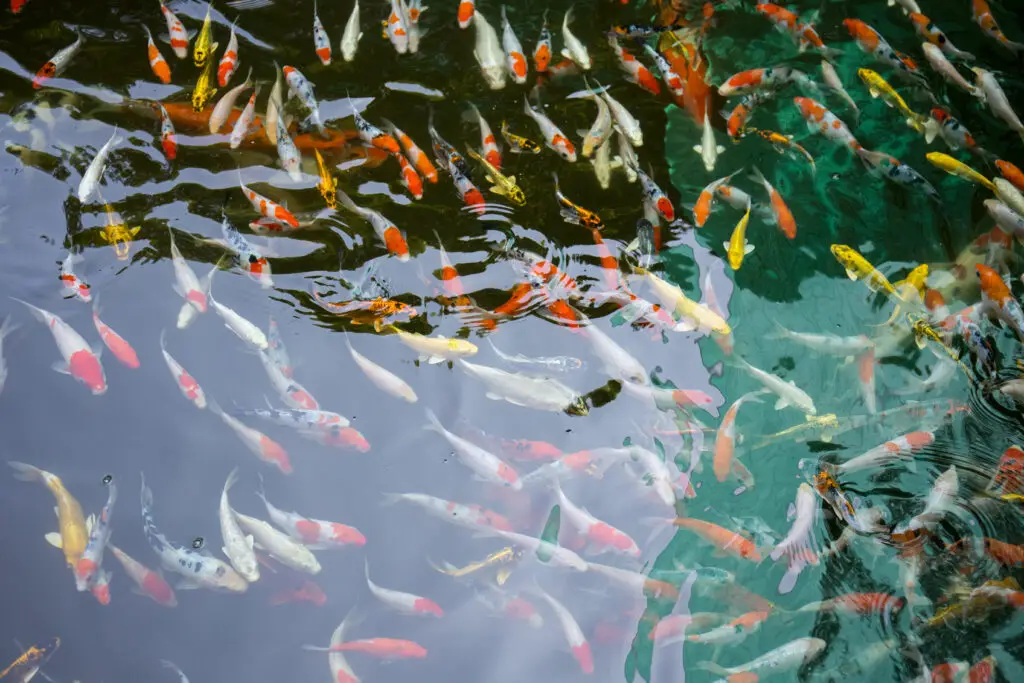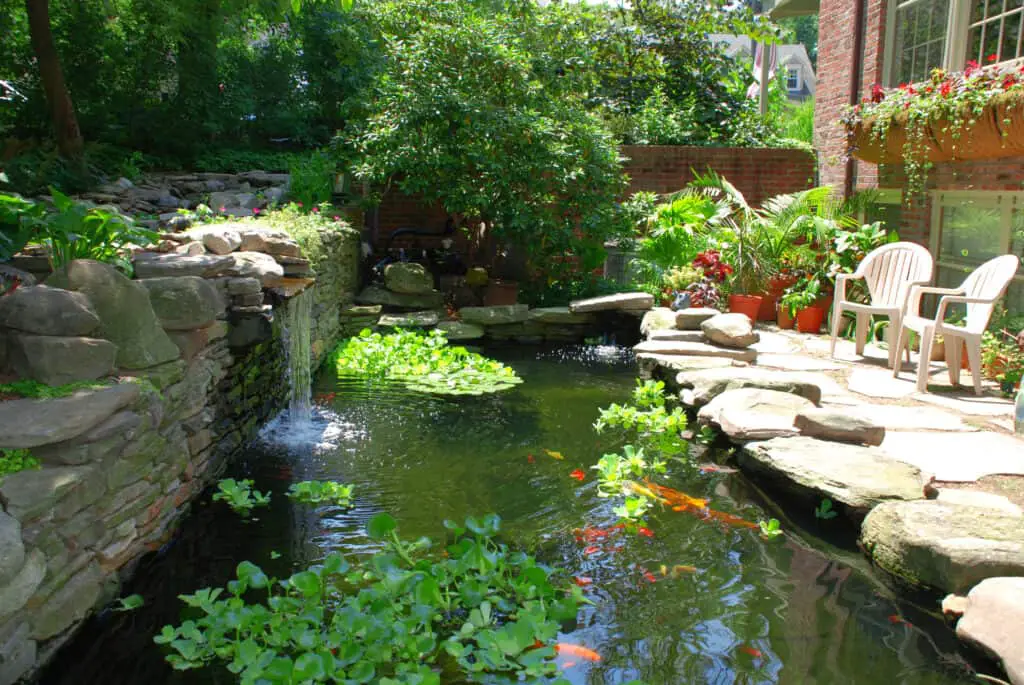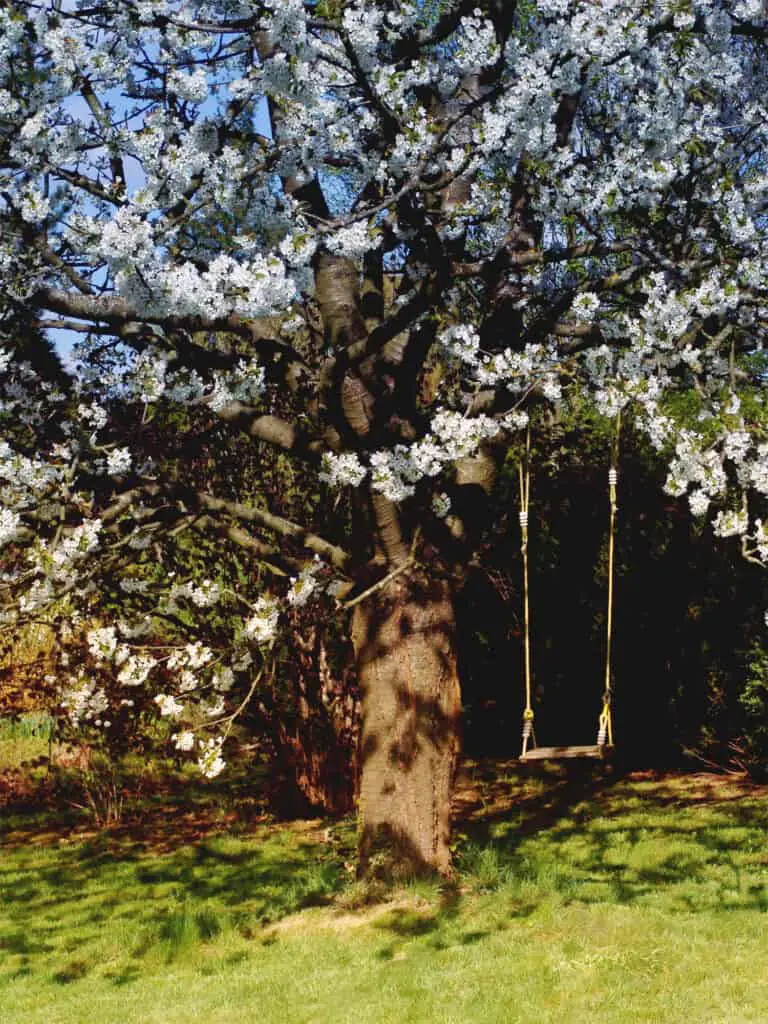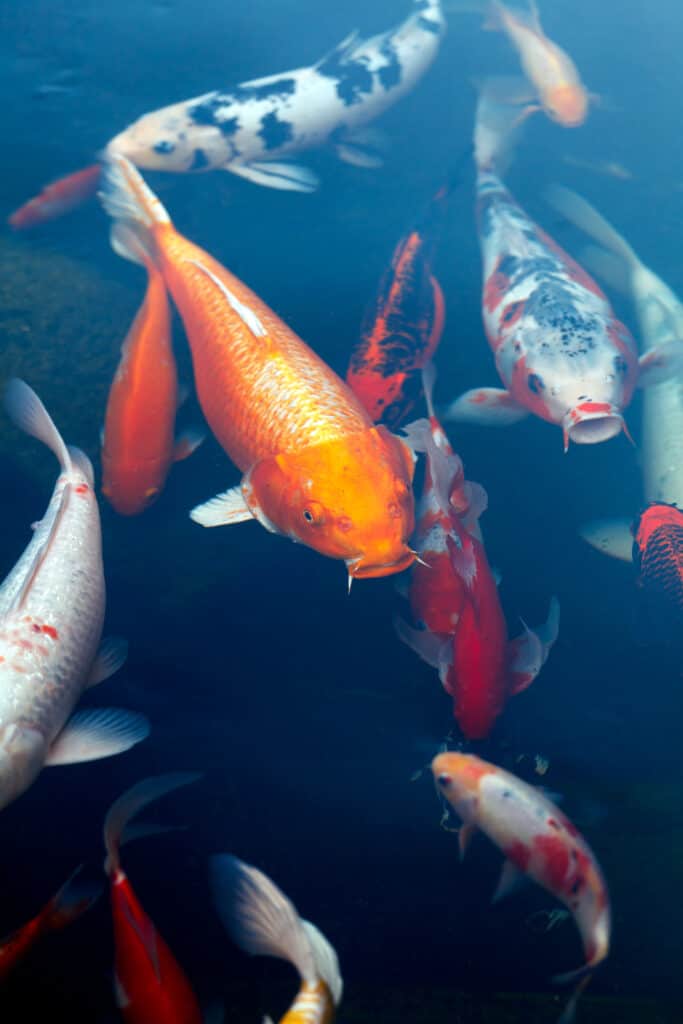
A lot of people don’t realize when they decide to build a koi pond that this type of fish requires a significant amount of space to thrive. A small koi pond will not be able to host a high number of fish, so you may find that a larger pond is needed to support the number of fish you desire to have.
Most koi ponds are built from one of three options. They will be built from a prefabricated mold, a pond liner, or concrete. You must consider several aspects of koi fish and their living requirements, ensuring that you design a pond that meets the fish’s needs and environment.
To build a large koi pond that will support a relatively high number of fish, you will most likely have to bring in a team that will be able to perform all the necessary labor. If your pond is professionally designed, you will ensure that it fits in with the design of the rest of your home’s external environment.
Pro Tip: If you’re tired of wasting money and making costly mistakes on the koi-keeping hobby or are thinking about buying koi fish but don’t know where to start, I strongly suggest you check out this ebook. I recently read this ebook, and it contains SO much useful information, such as:
- 3 proven steps to identify koi fish diseases
- WARNING: 3 things you should NEVER do when it comes to caring for koi
- When to seek professional help when it comes to looking after your koi
How To Build A Large Koi Pond
Design Considerations

To have around five fish comfortably homed in your koi pond, you will need a pond size of about 1000 to 1500 gallons. Your pond will need to be over three thousand gallons in volume for ten fish or more. It’s extremely important to consider the number of fish that will live in your pond to ensure it is not overpopulated.
A larger pond makes it easier to balance water levels while allowing space for more fish. However, a larger pond also means that you will need larger equipment to support it, such as pumps, filtration systems, and liners. If you ensure your pond is around four feet deep at one end, it will allow the koi a place to escape during the cold winter months.
Irrespective of the size of the pond, it is recommended that the depth is kept to a minimum of three feet to allow the koi to have sufficient space to thrive. The depth of the pond allows the koi fish to regulate their own body temperature, ensuring that they retain optimal health throughout their lifetime.
Bear in mind that building a large koi pond may require a permit to ensure that your project remains on the correct side of the building laws in your locale.
You must consider the accessibility of the pond within the confines of your property. You must also consider the visibility of the pond, as you will ordinarily want to be able to see the pond from within your home to enjoy it fully. It’s also equally important to ensure your koi pond has a cohesive design that works with the rest of your landscape.
Lastly, you must consider how the pond will be affected by its chosen location. This includes factors such as tree roots that may interfere with the pond and rainwater runoff that may cause havoc with your water health.

Your pond designer will also consider other infrastructural items, such as electrical lines and sewage, to ensure no potential interference.
Once the design and location have been carefully decided, you can begin construction.
Building Your Koi Pond
The first step in building your koi pond is excavation. You will first need to outline the entire perimeter of the pond while considering all the necessary components, such as the skimmer, falls, and pond filtration system. You can easily use paint for this part of the job.
Your excavation should include different levels instead of one hole with a continuous gradient. These levels will consist of shelves that will allow for placing plants and help create hiding places for the koi. The deepest part of the koi pond should be between three and four feet.
Once the excavation is complete, you can put the skimmer and spillway in place before backfilling. Place the flex pipe and the filter roughly in their intended positions. The next step is to line your excavated pond using an underlayment and an EPDM Liner with a 45mm thickness.
Always ensure that the liner extends past the furthest extents of the pond’s perimeter by at least a foot. This will ensure that you accommodate for settling soil.
Your skimmer must be attached to the pond liner using lap sealant. There will also be nuts and bolts provided with the skimmer that is used to secure everything in place. Once the above is complete, it will be time to begin putting your rocks into place. You will need to begin with the larger rocks before making your way to the smaller rocks.
To ensure the liner remains where it should be, you should add larger stones along the edges on the top surface and the first shelf.
If your pond has a waterfall, you should place waterfall foam between the rocks in the stream to prevent water from disappearing between the rocks.
Your next step is to connect your skimmer’s pump to the spillway. This is a relatively easy connection achieved with a PVC flex pipe with the pump subsequently placed at the rear of the skimmer. You will also need to connect your solids pump to your pressure filter and then back towards the spillway.
Now that the above is complete, you should start filling the pond with water, ensuring that you also add dechlorinators and starter bacteria. Once that is complete, run the pumps to ensure everything runs smoothly.
Now that your pumps run smoothly, it is time to add your plants and fish. However, this should be done only a few days after the water temperatures have become slightly warmer. Other items, such as lighting, can be added later as you see fit.
The Cost Of Building A Koi Pond
Labor expenditures, building materials, excavation, specialized equipment such as concrete mixers, and water to fill the pond are the first costs that come to mind while establishing a koi pond.
Naturally, the price of koi fish will be considered, which can be rather high, especially if you plan to buy adult koi fish.

When it comes to hidden costs, consider things like the electricity used to build the pond and the electricity used to keep the koi pond flowing.
Pumps are required for koi ponds, which can be an additional large upfront expenditure. The installation of filtering equipment is also a significant expense. Filtration systems for koi ponds can be quite complicated. They typically include several components as well as a variety of filter kinds.
To begin with, koi fish generate a substantial amount of waste product. This accumulation of koi fish waste must be removed from the koi fish’s surroundings to prevent a build-up over time.
Biological and mechanical filters will be used in a koi pond’s filtration system. When it comes to koi pond filtration systems, rocks, gravel, aquatic plants, and bacteria must all be addressed. All of the above will come with a price tag of varying degrees.
Incorporating safety features for the fish is a substantial cost that you may not have considered for koi ponds. While this is usually a design aspect that should be considered during the initial design process (ideally by an architect in partnership with a koi pond builder), it is also an extra cost that must be considered.
While safety features such as a net to protect the fish from potential predators can be built into the pond in carefully selected hiding locations, they can also be a simple addition, such as a net.
Conclusion
Embarking on a project to build a large koi pond is not a small undertaking. However, to host a large number of fish, you will need a large pond. With a project of this nature, it’s always best to hire a team of professionals to complete the job timeously and to the highest quality level.
By employing a professional architect, you will also ensure a well-designed pond at the end of the day while ensuring the best possible outcome for your investment.

